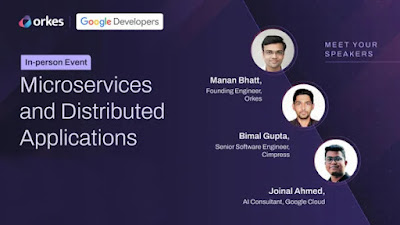In the world of Graphs, ML and Cloud...
These questions and many more were answered and elucidated in the insightful sessions by industry experts at the amazing event by Neo4j in association with Google | Google Developers - on "In the world of Graphs, ML and Cloud" at the Google Bengaluru Office on 11th December 2022. Attending & participating in this event made the sunday worthwhile and amazingly productive.
This event helped to learn about various
technologies, innovations, concepts, developments and real world use
cases of different technologies. There was an amazing lineup of speakers who shared insightful pieces of knowledge on various concepts. One of the main topics discussed at the
event was graphs. Experienced and highly knowledgeable speakers from
the pioneer company of graph database Neo4j , enlightened the audience about
the concept of graph databases, usefulness of graphs, underlying working
concepts and much more. #GraphsAreEverywhere
Siddhant Agarwal, the Tech Community Manager -APAC at Neo4j , hosted the session and shared some key points related to graph database. Graph database stores data in the form of nodes and relationships. All the data elements are basically stored as interconnected graphs of relationships. Having a graph database helps to have a superior performance in querying data, improves problem solving, its a powerful data modelling method & helps for faster traversal of connected data. Querying a graph database requires a different query language called the Graph Query Language (GQL) or Cypher which is created by Neo4j. This querying language is easier to learn and is in humane readable format. Graph database has multiple real-world use cases which include almost all technological domains like fraud detection & analytics, recommendation engine, identity & access management, social network graphs, telecommunications, data science, supply chain management to name a few. Graphs are perpetually existent in every application majorly in the tech-related industries.
Vishnu Ram OV, an industry leader in the field of telecommunication networks and the Vice Chair at International Telecommunication Union (ITU-T) Focus Group on Autonomous Networks, briefed upon Graph based representation and transformations of Autonomous Networks use cases in Neo4j. He also shared about the Build-A-Thon event by Indian Institute of Technology, Delhi (IIT-D). He described the use-case of Neo4j as a tool which can be used universally in various languages globally and moreover it is browser-based which helps to make it easier to use, accessible to all and user-friendly.
Pranshu Pareek, a software engineer at Netmeds, touched upon the major real-world use case of graph databases in the recommendation engines. He illustrated the helpfulness of graph database in the recommendation engines used by the e-commerce giants like Amazon & Flipkart. Graph databases helps the companies to increase their reach, hits and conversions by providing personalized recommendation of products, content or services.
Akshay Kumar U , a Flutter app developer and an innovator, showcased his amazing development & creation : Emergency Mitra : Emergency Ambulance Service using GCP suite and Flutter. As everyone is aware that traffic has been a interminable and perpetual problem in major cities of India. Often we notice that an ambulance or a fire safety vehicle gets stuck in the traffic deadlocks, so Akshay came up with an idea as a step to solve this problem. Emergency Mitra is an app which uses Google Maps, Firebase, Google Cloud Platform (GCP) & Neo4j to help the ambulance to avoid the traffic jam by fetching & querying the data in a graph database & using Google Maps, updates the ambulance driver about the traffic condition in real-time. Also, it can send signals using the real-time data to the traffic controller to manage the traffic flow so that ambulance can travel smoothly. Moreover, there is a functionality which queries the graph database to fetch the details of the ambulances available near a person and also helps the user to get an ambulance service through the Google Assistant as soon as possible. This project is really interesting and has great usefulness in the society.
Sasi Teja Kamsu, an industry expert, currently working in Confluent, gave an informative and engaging talk on Generative AI in which he
showcased real-world applications and use-cases of various
concepts like Generative Adversarial Networks(GANs) [Deepfakes] &
Generative Pre-Trained Transformer 3 (GPT3). He shared valuable pieces of information about the recent developments in the field of Deep Learning like the text-to-image models Stable Diffusion, Craiyon & DALL-E. He illustrated the logic and practicality of the trending artificial intelligence (AI) tool ChatGPT. He shared a few thought-provoking concepts of generative AI. Generative AI can take any content like images, text, audio, video,etc as input and process it and create completely new content. Hence, AI is processing content to generate new content and is then again processing new content to produce more content for it to process, which ultimately might be a looping process! The session was really interesting, insightful and intriguing.
So, to summarize my experience, it was a highly informative event which gave an opportunity for students, professionals , industry leaders and community members to get together and have a knowledge sharing session on trending, upcoming & core technologies. Events like these helps the community members to grow and learn together. It helps like-minded people and people with similar interests to network and discuss on various concepts, terminologies & technologies.
Really grateful to Neo4j, Google, Siddhant Agarwal & Prasad Seth (Community Manager at Google India) for hosting and organizing this wonderful event successfully.
Looking forward to learn, network, connect, experience and grow at more amazing events in future!







Insightful 👍
ReplyDelete